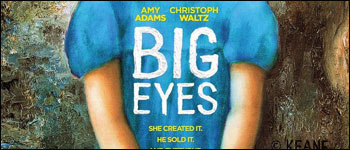
Release Date: Dec. 25
Verdict: Marked by inspired performances from Amy Adams and Christoph Waltz, Big Eyes is one of the movies that should be included in any regular moviegoer watching list this awards season.
Known for his fantastical worlds and characters, fascination of children and adults alike, Tim Burton could easily maintain the style that encompasses much of his work. In Big Eyes, however, the director takes another path, showing the world that there are no boundaries to his palette of colors and stories.
Set in California in the 1960s, the movie tells the true story of the painter Margaret Keane. While selling her paintings at an art fair one afternoon, Margaret meets Walter, a fellow artist. A professional relationship between the two quickly develops into a marriage after Margaret receives a letter in the mail with a judicial warning stating she can lose the custody of her daughter.
Looking to give her child a family environment, Margaret decides to marry. Soon after the wedding, however, Walter begins claiming the authorship of the sad eyes portraits painted by his wife. Margaret initially accepts this situation as Walter keeps bringing the money home and arguing that female painters struggle to sell their works.
Starring Amy Adams and Christoph Waltz, the film moves swiftly as Burton doesn’t need many strokes to get the story across the screen.
The director lets the story flow, relying on inspired performances by Adams and Waltz. The dialogue scenes gain not only from what it is said, but also on what the two actors can show through their expressions and eye contact.
When Margaret sees Walter lie for the first time about her work, Burton uses a long period of silence as the two characters must decide who will step up as the creator of the paintings.
This silent battle sets off the conflict between husband and wife, the businessman and the artist. It is an early victory for Walter, but the true winners of these battles are the viewers.
Both Adams and Waltz give life to characters whose frustrations and ambitions, qualities and flaws, are constantly in friction against each other. The richness of these characters is a gift to both actors whose talents shine on screen effortlessly.
Differently from other OSCAR contenders over the last few years, Big Eyes does not seek to impress the viewer with a complex story that lasts over the two-and-a-half hour mark.
The result is a movie that does not get dragged down by complicated plot lines or superfluous scenes. The constant flow is one of the main qualities of the screenplay. In Big Eyes, the screenwriters Scott Alexander and Larry Karaszewski rarely need long dialogue scenes. Every scene flows naturally from beginning to end without overstretching any situation beyond the screen time it deserves.
Burton uses this tight script well by playing with subtle details throughout the film. When Walter finds out he can make more money by selling the posters of paintings rather than the actual works, Burton inserts a scene of Margaret strolling through the supermarket passing in an aisle full of Campbell’s soups.
Once featured in the work of Andy Warhol, the Campbell’s cans provide an interesting visual commentary to Walter’s posters. No comparison could be better than Warhol who was able to combine talents for both art and business. Burton’s two main characters struggle for each only possesses one of these talents.
The movie focuses on the relationship between Walter and Margaret and never spends too much time discussing the state of art itself. Burton chooses wisely since the script does not seem flexible enough to support complex theories about art. The quick pace of the film discourages these discussions as the scenes keep flowing across the screen. This choice of pace is not necessarily a bad thing since the main story always stays in the forefront of the movie, but it also may disappoint those who are looking to dive deeper in the world of arts.
What results is a movie where Burton simply acts as a storyteller, not as a juggler of script gimmicks or a starter of philosophical discussions. He chooses to tell a story with straightforward shots and editing, letting his actors work their magic and the images tell more than words.

